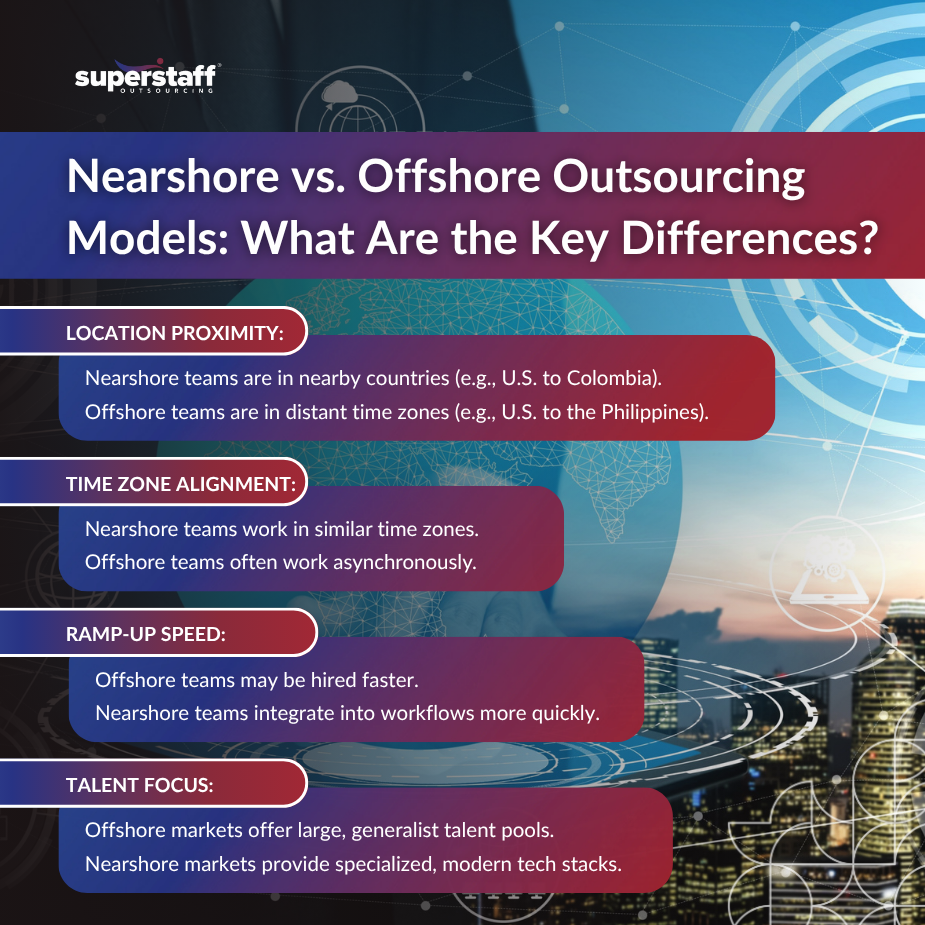
Startups and tech companies in hypergrowth mode face a critical decision: nearshore vs offshore? When every sprint counts and the next product milestone can make or break your momentum, how you scale your engineering team matters more than ever. The wrong hiring model could slow down innovation, increase burn, or strain your internal resources. The right one? It can give you the leverage to move faster, build smarter, and compete harder.
But the U.S. talent pool is stretched thin. With developer salaries surging and local recruiting pipelines struggling to keep pace, many companies are looking beyond borders. The global tech landscape now offers two clear paths: nearshore outsourcing—partnering with teams in nearby time zones like Colombia or Costa Rica—or offshore outsourcing—building teams in talent-rich hubs like the Philippines or India.
In the debate of nearshore vs offshore, there’s no one-size-fits-all answer. Your decision will shape how quickly you hire, how well your teams collaborate, and how efficiently you scale. This blog unpacks the strengths, trade-offs, and ideal use cases of both models—so you can make the right call with speed and confidence.
Understanding Nearshore vs Offshore Models
Before choosing a strategy, companies must understand how nearshore and offshore outsourcing differ in structure and scope.
Nearshore outsourcing refers to building teams in countries that are geographically and culturally closer to your headquarters—like U.S. companies hiring engineers through a Colombia call center or nearshore staffing company in LATAM. These teams often work within the same or adjacent time zones, making real-time collaboration much easier.
Offshore outsourcing, on the other hand, involves working with teams across the globe—typically in regions like Southeast Asia or Eastern Europe. For U.S. companies, offshore destinations include the Philippines, India, and Vietnam, where time zone differences can be more pronounced but cost savings are significant.
Key differences between nearshore vs offshore models include:
- Time zone overlap: Nearshore teams offer easier daily alignment.
- Travel distance: Nearshore destinations allow quicker onsite visits when needed.
- Communication ease: Language fluency and cultural familiarity are often higher in nearshore markets.
- Operational frameworks: Both models support staff augmentation, agile pods, or fully managed development teams.
Understanding these differences is crucial when weighing the nearshore vs offshore comparison for fast tech team growth. With definitions in place, let’s explore which model best meets the urgency of scaling.
Time-to-Scale: Which Model Ramps Faster?
When urgency drives your hiring timeline, nearshore and offshore models offer different paths to speed.
If your internal team is already stretched thin, the ability to onboard developers quickly becomes a top priority. Offshore models, especially in countries like the Philippines, often offer a much larger pool of readily available developers. Their experience with high-volume outsourcing operations means faster recruitment, particularly for roles like QA testers, back-end developers, or tech support specialists.
Nearshore teams, however, typically ramp faster after onboarding. Because they work in near real-time with your core team, integration into existing workflows is smoother. For instance, daily standups and agile ceremonies are far easier with a Colombia-based nearshore staffing company than with a team operating on a 12-hour time difference.
- Lead time for onboarding: Offshore may staff faster, but training and collaboration take longer.
- Synchronous vs asynchronous work: Nearshore supports real-time development cycles; offshore may require more asynchronous planning and documentation.
- Emergency response and troubleshooting: Nearshore teams can resolve critical issues faster during U.S. business hours.
Speed matters—but not at the expense of quality. Let’s evaluate the trade-off between cost and collaboration.

Cost vs. Collaboration: What Are You Willing to Trade?
Lower costs often come with trade-offs in communication and management overhead.
In a pure numbers game, offshore models win on cost. Hiring a developer in the Philippines through an offshore partner often comes at lower cost than a nearshore equivalent. This makes offshore a powerful option for companies under budget pressure or looking to build larger dev teams.
However, collaboration costs—such as delays, miscommunication, and managerial overhead—are often underestimated. Nearshore teams, while slightly more expensive per hour, may yield higher productivity per hour due to better alignment.
- Real cost of poor communication: Misunderstandings during product sprints or missed requirements can cause expensive delays.
- Productivity vs hourly rate: One hour of synced collaboration often equals multiple hours of async back-and-forth.
- Hidden costs of rework: Misaligned development can lead to increased QA cycles or total refactors.
If your project requires rapid iteration and constant feedback loops, nearshore may be worth the premium. Next, let’s evaluate talent quality and specialization.
Talent Pool Depth and Tech Specialization
The success of your project depends on the expertise of your team—not just their location.
Offshore markets like the Philippines boast massive talent pools. These regions produce thousands of engineering graduates annually and are home to mature outsourcing ecosystems. They’re particularly strong in support roles, legacy tech maintenance, and high-volume development work.
Nearshore countries like Colombia, by contrast, are emerging as niche tech hubs. Colombia call centers are evolving into tech talent centers, offering developers with deep specialization in modern stacks like React, Node.js, Python, and DevOps.
Here are the factors you should take into consideration:
- Skills availability: Offshore offers volume; nearshore offers specialization.
- Language fluency: Nearshore developers tend to have stronger English proficiency and experience working with North American teams.
- Tech maturity: Colombia’s nearshore staffing companies often invest in certifications and continuous training to compete with global markets.
Both models offer access to world-class talent—but the ideal source depends on your technical stack and the level of specialization you need. Beyond skills, team cohesion is another factor to weigh.
Cultural Compatibility and Work Ethic
Smooth communication and team cohesion hinge on cultural alignment.
Developing software isn’t just about writing code—it’s about interpreting feedback, collaborating creatively, and understanding end-user expectations. That’s why cultural compatibility matters.
Nearshore teams in countries like Colombia generally align more closely with U.S. work culture. Shared holidays, similar business norms, and a collaborative ethos create smoother working relationships. A Colombia call center repurposed into a dev support hub might feel just like working with someone in Miami or Austin.
Offshore teams may require a longer cultural ramp-up. Differences in communication style, hierarchy, and holiday calendars can cause misalignment without proper onboarding.
Here are a few factors you should consider:
- Managerial overhead: Offshore teams may require more frequent check-ins or detailed instructions.
- Autonomy and initiative: Nearshore engineers are often encouraged to challenge assumptions and proactively contribute.
- Trust-building: Easier with real-time collaboration and cultural alignment.
To wrap it up, let’s break down exactly when to choose each model—based on your company’s current stage and needs.
When to Choose Nearshore vs Offshore: Your Quick Decision Matrix
The right model depends on your company’s growth stage, budget, and management capacity.
No two companies scale the same way. That’s why a strategic nearshore vs offshore comparison for fast tech team growth should start with a clear understanding of what you need today—and what you’ll need three months from now.
- Choose offshore if:
- You need to scale quickly on a tight budget.
- Your project is modular and doesn’t require real-time collaboration.
- You have experienced internal managers who can oversee distributed teams.
- Choose nearshore if:
- You need agile sprints, daily standups, and real-time feedback.
- Your product is in a rapid prototyping or iteration phase.
- You want cultural alignment and strong communication from Day 1.
Checklist to guide your decision:
- What’s your time-to-hire target?
- Do you need developers in the same time zone?
- Is budget or productivity your priority?
- How complex is your tech stack?
- How much oversight can your in-house team realistically provide?
Hybrid model considerations:
Many companies blend the two: nearshore for core product teams, offshore for support, QA, or maintenance roles. This hybrid approach offers the best of both worlds—speed, scale, and smart cost management.
Still Torn Between Nearshore vs Offshore Tech Solutions? Implement a Hybrid Strategy With SuperStaff
Whether nearshore or offshore, the smartest choice depends on your specific scaling priorities. Nearshore offers real-time collaboration, cultural fit, and smoother team integration. Meanwhile, offshore delivers massive cost savings and access to deep labor pools.
Here’s the good news: Both models can work—if your partner understands your goals and your structure is intentional.
At SuperStaff, we help fast-growing companies scale their dev teams quickly and effectively—whether you’re building with a Colombia call center team or an offshore pod in the Philippines. Let’s talk about how a nearshore staffing company or offshore partner can drive your next sprint forward—fast.






